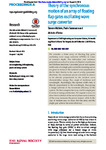Theory of the synchronous motion of an array of floating flap gates oscillating wave surge converter
| dc.contributor.author | Michele, Simone | |
| dc.contributor.author | Sammarco, P | |
| dc.contributor.author | d’Errico, M | |
| dc.date.accessioned | 2021-08-09T14:31:46Z | |
| dc.date.available | 2021-08-09T14:31:46Z | |
| dc.date.issued | 2016-08 | |
| dc.identifier.issn | 1364-5021 | |
| dc.identifier.issn | 1471-2946 | |
| dc.identifier.other | ARTN 20160174 | |
| dc.identifier.uri | http://hdl.handle.net/10026.1/17510 | |
| dc.description.abstract |
<jats:p>We consider a finite array of floating flap gates oscillating wave surge converter (OWSC) in water of constant depth. The diffraction and radiation potentials are solved in terms of elliptical coordinates and Mathieu functions. Generated power and capture width ratio of a single gate excited by incoming waves are given in terms of the radiated wave amplitude in the far field. Similar to the case of axially symmetric absorbers, the maximum power extracted is shown to be directly proportional to the incident wave characteristics: energy flux, angle of incidence and wavelength. Accordingly, the capture width ratio is directly proportional to the wavelength, thus giving a design estimate of the maximum efficiency of the system. We then compare the array and the single gate in terms of energy production. For regular waves, we show that excitation of the out-of-phase natural modes of the array increases the power output, while in the case of random seas we show that the array and the single gate achieve the same efficiency.</jats:p> | |
| dc.format.extent | 20160174-20160174 | |
| dc.language | en | |
| dc.language.iso | en | |
| dc.publisher | The Royal Society | |
| dc.rights | Attribution 4.0 International | |
| dc.rights | Attribution 4.0 International | |
| dc.rights | Attribution 4.0 International | |
| dc.rights.uri | http://creativecommons.org/licenses/by/4.0/ | |
| dc.rights.uri | http://creativecommons.org/licenses/by/4.0/ | |
| dc.rights.uri | http://creativecommons.org/licenses/by/4.0/ | |
| dc.subject | floating flap gate energy | |
| dc.subject | wave-body interaction | |
| dc.subject | resonance | |
| dc.title | Theory of the synchronous motion of an array of floating flap gates oscillating wave surge converter | |
| dc.type | journal-article | |
| dc.type | Journal Article | |
| plymouth.author-url | https://www.webofscience.com/api/gateway?GWVersion=2&SrcApp=PARTNER_APP&SrcAuth=LinksAMR&KeyUT=WOS:000391097000015&DestLinkType=FullRecord&DestApp=ALL_WOS&UsrCustomerID=11bb513d99f797142bcfeffcc58ea008 | |
| plymouth.issue | 2192 | |
| plymouth.volume | 472 | |
| plymouth.publication-status | Published | |
| plymouth.journal | Proceedings of the Royal Society A: Mathematical, Physical and Engineering Sciences | |
| dc.identifier.doi | 10.1098/rspa.2016.0174 | |
| plymouth.organisational-group | /Plymouth | |
| plymouth.organisational-group | /Plymouth/Faculty of Science and Engineering | |
| plymouth.organisational-group | /Plymouth/Faculty of Science and Engineering/School of Engineering, Computing and Mathematics | |
| plymouth.organisational-group | /Plymouth/Users by role | |
| plymouth.organisational-group | /Plymouth/Users by role/Academics | |
| dc.identifier.eissn | 1471-2946 | |
| dc.rights.embargoperiod | Not known | |
| rioxxterms.versionofrecord | 10.1098/rspa.2016.0174 | |
| rioxxterms.licenseref.uri | http://creativecommons.org/licenses/by/4.0/ | |
| rioxxterms.type | Journal Article/Review |



